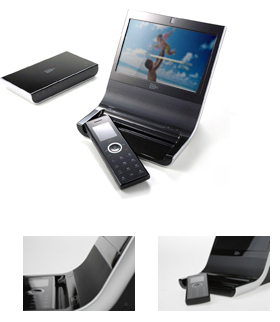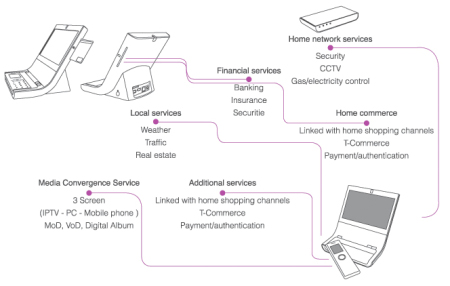Korean vendor readies Android MID, clamshell, STB
Nov 25, 2009 — by Eric Brown — from the LinuxDevices Archive — 10 viewsKorea-based Inbrics is readying several Android-powered devices for a CES unveiling in January. The devices include an M1 MID, a dual-screen clamshell, MID-like device called the Dual, and the SoIP Homestation, which combines the functions of an IP set-top box, DLNA-ready media server, and videophone, says the company.
Inbrics is primarily a VoIP phone vendor, but is in the midst of rolling out a number of consumer electronics devices based on its own Android-based stack (see farther below for an architecture diagram). The company posted a spec sheet for the Dual, and it also offers some information on the SoIP Homestation, but it has provided very little on the M1 MID (mobile Internet device).
According to a report in CNET Asia, however, the M1 is the closest to market, and will be shown by Ingenics at the Consumer Electronics Show (CES) 2010, to be held on Jan. 7-10 in Las Vegas. It is unclear which of Ingenics' other devices will be shown, but the slick YouTube commercial farther below suggests that they might all be on display as prototypes, if not fully functioning demo models.

Inbrics M1 MID
Inbrics Dual
The Dual is more interesting, offering a clamshell design that incorporates dual 4-inch WVGA touchscreens, somewhat like a smaller version of the Android-based Entourage Edge e-reader from Entourage Systems. The 5.1 x 2.4 x 0.6-inch (preliminary) clamshell offers a 360-degree flexible screen that can lay flat or be propped up in sandwich-board fashion.

Inbrics Dual
(Click to enlarge)
Inbrics Linux/Android software architecture, used by M1, Dual, and SoIP
(Click to enlarge)
Inbrics lists the Dual's processor as being "ARM Cortex," with support for OpenGL ES 2.0, which suggests one of the above-listed Cortex-A8 SoCs. The device offers 512MB RAM, 16GB to 32GB flash, and a micro-SD slot for expansion. A three-megapixel camera is also included along with audio/video connectivity.
Wireless to the max, the device provides WiFi, Bluetooth, and WiBro, the Korean flavor of mobile WiMAX. It also offers the aforementioned T-DMB mobile TV capability, says Inbrics.
The company makes no mention about 3G service, although the Dual is billed as being a smartphone, as well as a PMP (portable media player), game console, and VoIP phone. As can be seen in the annotated photo above, it is also billed as offering "dual activation," although this may be referring to functionality as opposed to cellular service. It is unclear whether the two screens have dedicated functions or whether both displays provides access to the full list of features.
Specifications listed for the Inbrics Dual include:
- Processor — ARM Cortex with OpenGL ES 2.0 support
- Memory — 512MB RAM
- Flash — 16/32GB NAND flash
- Flash expansion — Micro-SD card
- Display — 2 x 4-inch WVGA, 262K color touchscreens
- Camera — 3-megapixel autofocus and VGA CMOS
- Wireless:
- WiFi
- WiBro
- Bluetooth
- T-DMB 174-240MHz, TPEC mobile video
- Other features:
- Mini-USB port
- A/V Out
- 3.5mm earphone jack and earphone
- Stereo speaker
- Power jack
- Stylus pen
- Korean and English language support
- MPEG 1-4 playback, among other formats
- Battery — Li-Poly Standard (min. 2400mAh)
- Dimensions — 5.1 x 2.4 x 0.6 inches (130 x 60 x 16mm) preliminary
- Operating system — Android
SoIP Homestation
The third Android device, the SoIP Homestation, is listed as a media convergence device for IP-based infrastructure and service integration. That appears to suggest it will be sold by service providers.
The DLNA-ready IP set-top box (STB) can share digital content from mobile phones, IPTV services, the web, home network content from PCs and other devices, as well as security camera feeds, says Inbrics. Features are said to include mobile video calls, IPTV control, and video calls.

SoIP Homestation
Equipped with WiFi, as well as LAN, WAN, and USB ports, the device connects to an HDTV via HDMI. Other features are said to include a 3.5 Watt stereo speaker, an earphone jack, as well as an IC card reader for SmartCard support, and a two-megapixel webcam.

SoIP Homestation in typical use scenarios
(Click to enlarge)
Inbrics YouTube commercial
Availability
More information on the M1, Dual, and SoIP Homestation devices may be found at Inbrics, here. The CNET Asia story on the Inbrics M1 and Dual should be here.
This article was originally published on LinuxDevices.com and has been donated to the open source community by QuinStreet Inc. Please visit LinuxToday.com for up-to-date news and articles about Linux and open source.
